
a web page by Don Roberson |
NEW ZEALAND WATTLEBIRDS Callaeidae |
||
|
||
Two species of wattlebirds went extinct during the 20th century: Huia and South Island Kokako. |
||
All wattlebirds have a distinctive fleshy wattle at the gape. It is orange in all species, extant or extinct — including North Island Saddleback (left & below) — except in North Island Kokako, in which it is blue (see farther down the page). The South Island Saddleback Philesturnus carunculatus is much like the North Island bird except that it has a distinct juvenal plumage that is all-brown, giving rise to the local name "jackbird." Juvenal plumage in North Island Saddleback is similar to adults. Before 1964, North Island Saddleback was entirely restricted to Hen I. in the Hauraki Gulf (below right). During a pelagic trip in Nov 2009, we anchored off the lee side of Hen I. and turned off the engine — and were able to hear saddlebacks from the last entirely native population calling. It was from Hen I. that saddlebacks have been translocated to 13 other islets off mainland North Island. |
||
|
||
The South Island Kokako Callaeas cinereus was likely extinct by the 1960s; it was declared officially so in 2007. |
||
North Island Kokako has a hauntingly beautiful voice: a series of loud, rich notes as if produced by a huge pipe-organ in a giant cathedral. Both sexes sign, sometimes in duet. Because a kokako is shy and secretive, the vocalizations are usually the first indication of their presence. Saddlebacks are very noisy, but it is a loud, repetitive chattering song, with harsher churring and chatters. |
||
The largest member of the family was the Huia Heteralocha acutirostris, whose behavior and calls were said to be somewhat like Kokako. Both sexes had long decurved bills but the structure of each was different: males chiseled into rotten wood while females probed into holes and crevices. They apparently specialized on the grubs of the huhu beetle Prionoplus reticularis (Scofield 2009). The extinction of both species of Saddleback from mainland islands was due to the introduction of rats (both brown rat and black rat), and rats affected both species of Kokako as well. It was the later introduction of mustelids – mongoose, ferrets — that doomed much mainland kokakos. Feral cats added to the problem; Huia were also pressured by hunting for their feathers. Loss of habitat wiped out the rest. Saddlebacks rapidly disappear from any offshore islets on which rats become introduced; the populations of South Island Saddleback are now extinct from the original three 'donor' islands from which they were translocated elsewhere. Fortunately, rats have recently been eliminated from those islands and re-introductions on them is planned. There are thus no entirely wild native populations of South Island Saddleback anywhere; the only entirely wild non-relocated North Island Saddlebacks are on Hen I. in the Hauraki Gulf. |
||
Photos: The photos of North Island Saddleback Philesturnus rufusater are from Tiritiri Matangi I., off North Island, New Zealand, in in Jan 1999 (top) and Nov 2009 (rest). The North Island Kokako Callaeas wilsoni was on Tiritiri Matangi I., off North Island, New Zealand, in Nov 2009. Photo © D. Roberson; all rights reserved. Bibliographic note: There is no "family book" per se, but a fine introduction to this family, with some fine photos, is in Scofield (2009). Literature cited:
|
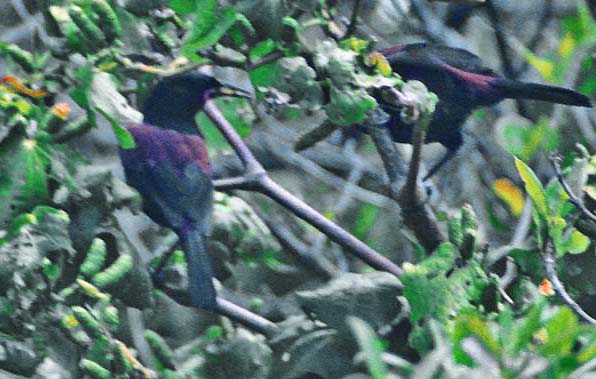 The
New Zealand wattlebirds are part of an ancient radiation of largish
passerines to New Zealand in the early Tertiary. Traditionally it was
said that only two remained extant: Saddleback and Kokako (e.g.,
Dickinson 2003). Recent evidence suggests that both Saddleback and
Kokako should be split into North Island and South Island species
(summarized by Scofield 2009). Thus the one most readily seen —
reintroduced to Tiritiri Matangi I. reserve — is North Island Saddleback (left).
The
New Zealand wattlebirds are part of an ancient radiation of largish
passerines to New Zealand in the early Tertiary. Traditionally it was
said that only two remained extant: Saddleback and Kokako (e.g.,
Dickinson 2003). Recent evidence suggests that both Saddleback and
Kokako should be split into North Island and South Island species
(summarized by Scofield 2009). Thus the one most readily seen —
reintroduced to Tiritiri Matangi I. reserve — is North Island Saddleback (left). 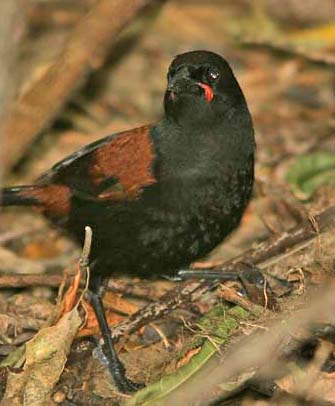 My experience with North Island Saddleback
is very limited, but on a recent visit to Tiritiri the birds seemed to
stay mostly in the undergrowth, and spent a lot of time on the ground,
probing and flicking through the leaf litter the way towhees and Fox
Sparrows do back home in California (right & below left). All
wattlebirds are omnivorous, and may feed at any level in the forest,
but saddlebacks to "feed predominantly on insects gleaned form leaf
litter on the forest floor or in rotting logs" (Scofield 2009).
My experience with North Island Saddleback
is very limited, but on a recent visit to Tiritiri the birds seemed to
stay mostly in the undergrowth, and spent a lot of time on the ground,
probing and flicking through the leaf litter the way towhees and Fox
Sparrows do back home in California (right & below left). All
wattlebirds are omnivorous, and may feed at any level in the forest,
but saddlebacks to "feed predominantly on insects gleaned form leaf
litter on the forest floor or in rotting logs" (Scofield 2009). 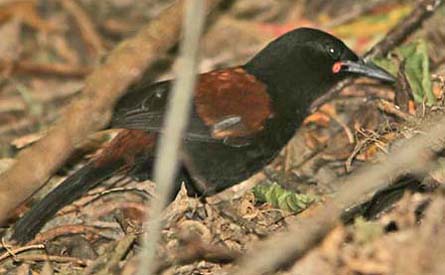
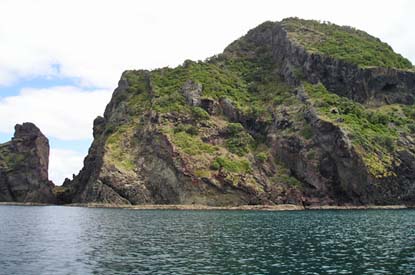
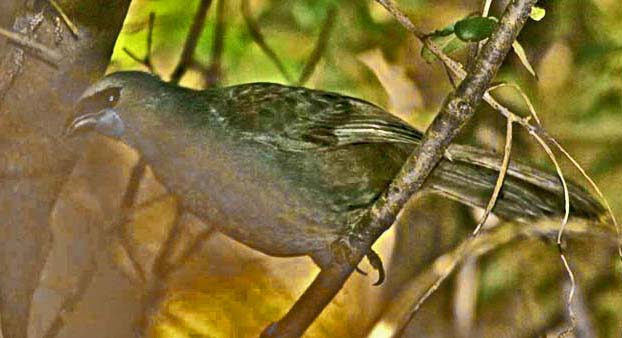 North Island Kokako
still exists on the mainland in remnants of native forest, but is
exceptionally difficult to find there. It has been reintroduced to
three offshore islets, including Tiritiri (right), where it has begun
to breed. It remains classified as Endangered everywhere.
North Island Kokako
still exists on the mainland in remnants of native forest, but is
exceptionally difficult to find there. It has been reintroduced to
three offshore islets, including Tiritiri (right), where it has begun
to breed. It remains classified as Endangered everywhere.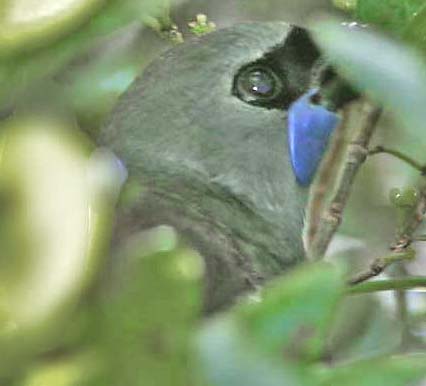 North Island Kokako
is the only wattlebird with blue wattles (left). While omnivorous, this
species has been described as a "sequential specialist" as its diet
changes as the abundance of food changes. It eats primarily fruit,
leaves, or blossoms, and it forages by climbing slowly up each tree
while searching for food, and then gliding to the next tree (Scofield
2009). Like all wattlebirds, it is a weak flier and prefers to glide
rather than flap. I have heard its behavior described as
"squirrel-like" as it bounds up through the various levels of a tall
forest tree.
North Island Kokako
is the only wattlebird with blue wattles (left). While omnivorous, this
species has been described as a "sequential specialist" as its diet
changes as the abundance of food changes. It eats primarily fruit,
leaves, or blossoms, and it forages by climbing slowly up each tree
while searching for food, and then gliding to the next tree (Scofield
2009). Like all wattlebirds, it is a weak flier and prefers to glide
rather than flap. I have heard its behavior described as
"squirrel-like" as it bounds up through the various levels of a tall
forest tree.